FIRST AID KIT
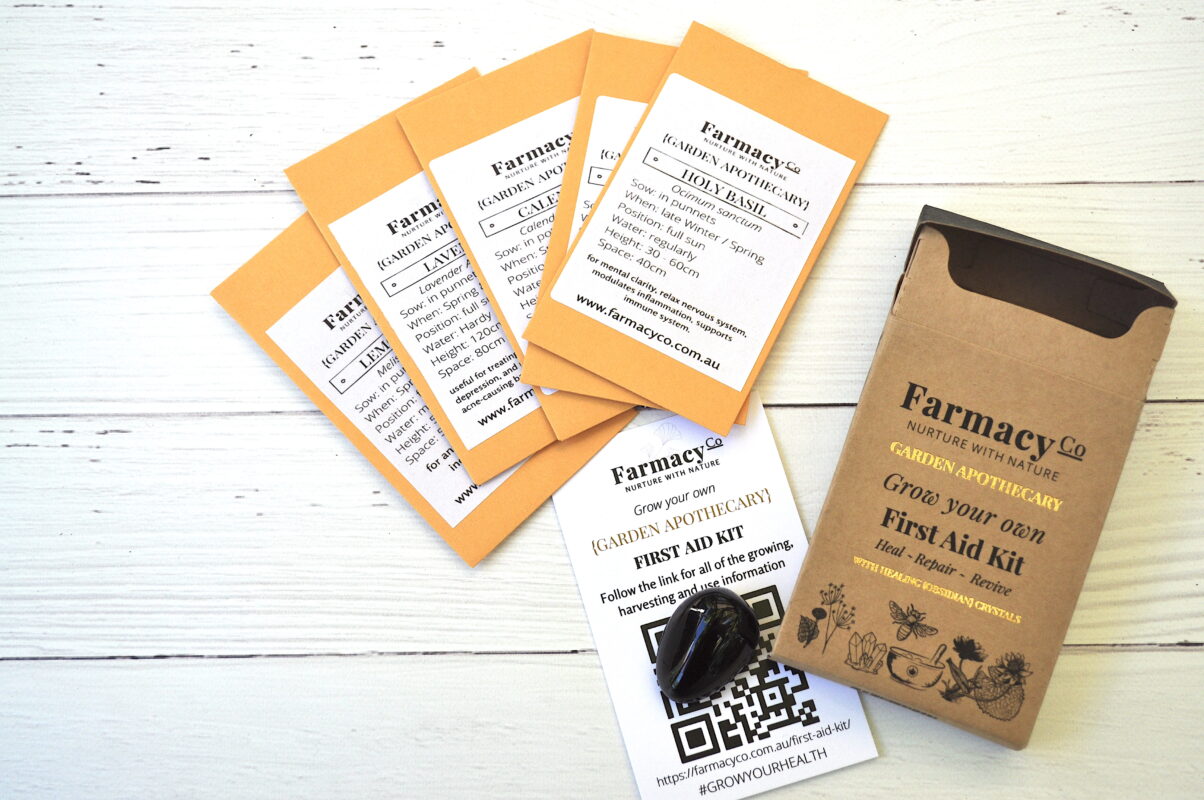
Congratulations on making the choice to Grow your health with our Garden Apothecary First Aid Kit.
In this pack you’ll find 5 different herb varieties to grow in your garden or on your balcony and Obsidian crystals to add a little extra magic to your plants.
Lets start with each herb and how to grow them, what they look like and how to harvest, then we’ll move onto some recipes to get the most benefit from your medicinal herbs.
GROW
CALENDULA
| Method: | Sow direct or raise seedlings |
| Sowing Depth: | 15mm |
| When: | Spring and autumn |
| Germination: | 7-14 days @ 20-22°C |
| Hardiness / Life Cycle: | Hardy Annual |
| Plant Spacing: | 50cm |
| Plant Height: | 60cm |
| Position: | Part or full sun, moist soil |
| Days to Maturity/Flowering: | 70-80 days |
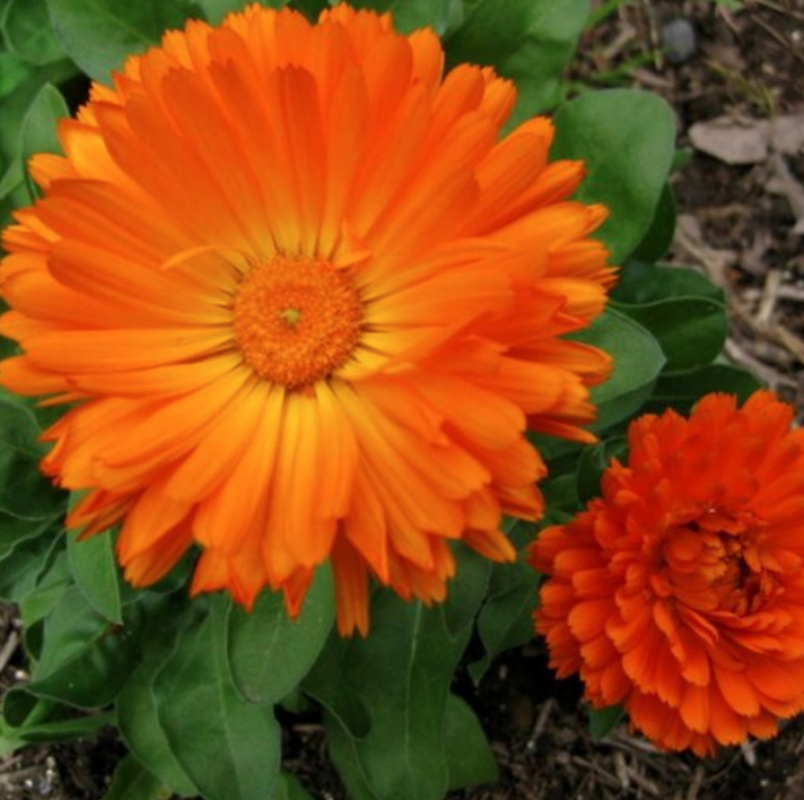
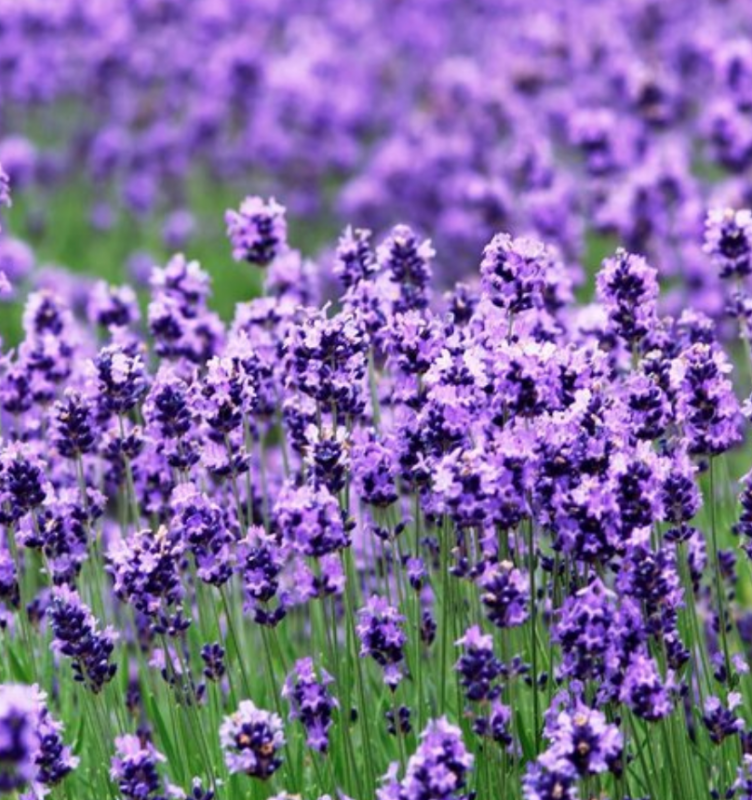
LAVENDER
| Method: | Raise seedlings |
| Sowing Depth: | 5mm |
| When: | Spring, summer and early autumn |
| Germination: | 14-21 days @ 18-21°C |
| Hardiness / Life Cycle: | Hardy Perennial |
| Plant Spacing: | 80cm |
| Plant Height: | 120cm |
| Position: | Full sun, moist well drained soil |
| Days to Maturity/Flowering: | 356 days |
LEMON BALM
| Method: | Raise seedlings |
| Sowing Depth: | 3mm |
| When: | Spring |
| Germination: | 7-14 days @ 19-21°C |
| Hardiness / Life Cycle: | Hardy Perennial |
| Plant Spacing: | 50cm |
| Plant Height: | 50cm |
| Position: | Part or full sun, moist well drained soil |
| Days to Maturity/Flowering: | 60-70 days |
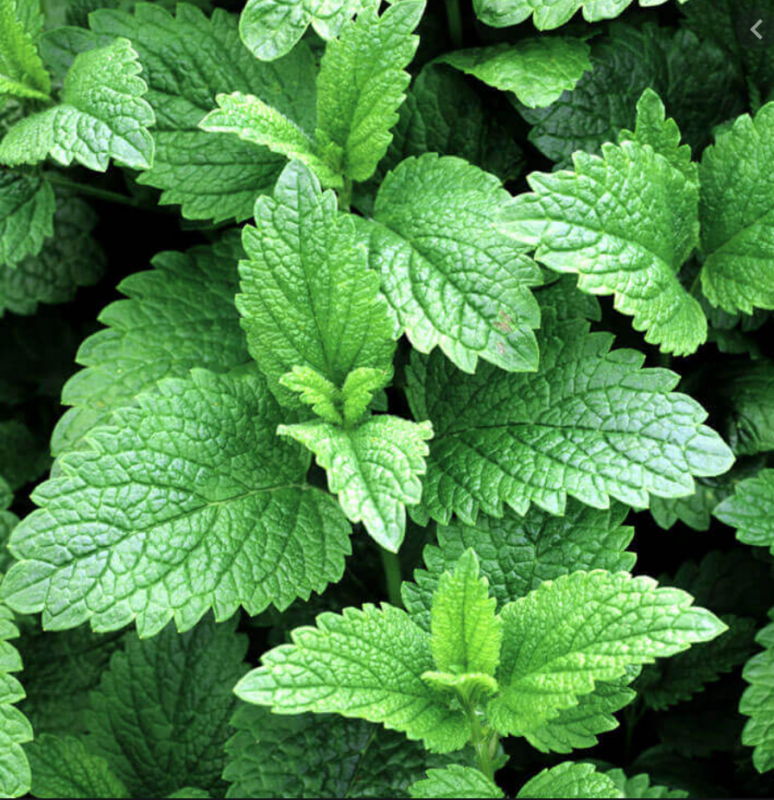
SPILANTHES
| Method: | Raise seedlings or Sow direct |
| Sowing Depth: | 1mm |
| When: | Spring after frost |
| Germination: | 5-7 days @ 22-24°C |
| Hardiness / Life Cycle: | Frost Tender Perennial (grown as an annual in cool climates) |
| Row Spacing: | 50cm |
| Plant Spacing: | 30cm |
| Plant Height: | 45-60cm |
| Position: | Part sun to Full sun, moist well drained soil |
| Days to Maturity/Flowering: | 120+ days |

Spilanthes common name is the ‘Toothache’ plant. Leaves have a unique flavour and a tingly cool sensation when consumed, they can be eaten fresh, added to salads or cooked like greens. Traditionally used as a medicinal herb to treat toothache and throat infections due to its anti-inflammatory and saliva producing properties. Useful as a natural insecticide. Flower heads can be used fresh or dried and are often used in cocktails due to their unusual cooling and numbing sensation when consumed
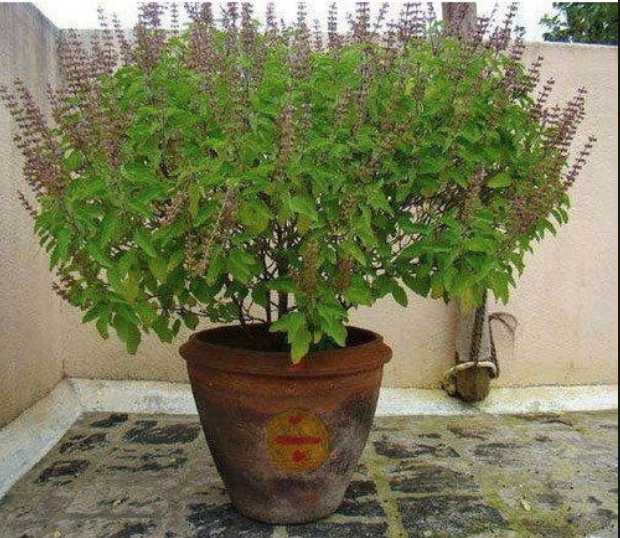
TULSI ~ HOLY BASIL
| Method: | Raise seedlings |
| Sowing Depth: | 1mm |
| When: | Spring and early summer |
| Germination: | 8-14 days @ 21-23°C |
| Hardiness / Life Cycle: | Half hardy Annual |
| Plant Spacing: | 40cm |
| Plant Height: | 30-60cm |
| Position: | Full sun, moist well drained soil |
| Days to Maturity/Flowering: | 100-110 days |
HARVEST
CALENDULA
Part Used – Flower
How – The best time to harvest calendula flowers is in the morning after the dew has dried. They are fresh, opening to the sun, but don’t have wet petals. You should also harvest the blossoms when they are half-open. Soon after this point they open more and are past their prime medicinally, and the petals begin to wither.
Snipping off the flower head at the top of the stalk is the standard way to harvest calendula. Use scissors or your fingers to pinch the stem. You could also pull entire plants and include the leaves, which have much of the same medicinal quality as the flowers, but it’s so much easier to continually harvest flower blooms from a patch of calendula throughout the season.
Spread them onto a ventilated surface: cloth, screen, a mesh of some type. You can build drying screens from light lumber and screen―make a frame and staple screen to it. You can even build a cabinet to hold the screens and put a fan in it to circulate air. Store in an air tight jar.
LAVENDER
Part Used – Flowers
How – The best time to harvest English lavender is when the buds have formed on the plant but the flowers have not yet opened. Lavender flowers harvested at this time of year will fall off the stems more easily when dry, making it easier to collect. Closed buds will also retain fragrance and colour longer. To harvest English lavender, use sharp pruners and gather a small handful of long flower stems. Be sure that you are leaving behind at least two sets of leaves on the green part of the stem. If you cut all the way back to the woody part of the stem, that stem will not regrow. I like to be generous and leave at least 3-4 sets of leaves on the plant, then go back and prune it to two sets of leaves on the green stem. Tie these bunches and hang in a dry dark spot until dried.
LEMON BALM
Part Used – Leaves
How – You can harvest handfuls of lemon balm leaves for fresh use almost any time during the growing season. For a large harvest of leaves that will be dried for tea or medicinal use, it is preferable to wait until the plant begins to put on flower buds or just as the flowers begin to open. This is when the volatile oils in the leaves are at their greatest concentration.
When you are ready, cut each stem just above a pair of leaves using a very sharp pair of scissors or pruning shears. You can cut the plant down to within six to eight inches of the soil. A good rule of thumb is to remove no more than two-thirds of the vegetative growth at any one time. Finish the job by pruning stray stems and shaping so the plant looks tidy, and then water it deeply. Once you have your basket full of cut stems, you will need to process them for drying. Drying is the only way to preserve the quality and flavour of lemon balm for long-term storage, though.
SPILANTHES
Part Used –The entire Spilanthes plant, from root to flower, has medicinal value. Even better, it’s fairly easy to grow in the garden.
How – After a month or so in the garden, spilanthes begins to produce the characteristic flowers that make it so entertaining. Harvest the flowers periodically before they go to seed, and dry them on screens. The flower buttons are dense, so drying them on screens with good air circulation helps prevent mould.
Once they are dry, you can use them to make tea or an extract. The leaves can be dried and used as a milder alternative to the flowers, and spilanthes can also be used fresh for the same purposes.
TULSI
Part Used – Leaves
How – You can begin to harvest tulsi once the plant reaches about 30cm in height. Pinch back the growing tips to help encourage a bushy plant habit, which will increase yields. Tulsi plants should be ready for harvest about 40 days after germination and do best with sparse periodic harvests. You can dry the leaves as you harvest them.
USE
CALENDULA
As the active ingredient in Boiron Calendula Cream, Calendula soothes and promotes healing of cuts, scrapes, chafing, minor burns and sunburn. It’s a must-have for your family’s first aid kit.
Make a Calendula oil
- Place calendula petals in a clean, dry glass jar. Next, pour in the carrier oil – add enough so that the petals are covered by about one inch of oil. My petals usually float when I first add the oil and then settle, so I watch the bottom of the jar to make sure there’s about 1 inch of pure oil so that I’m sure I’ve added enough. The reason this is done is that the petals expand as they soak in the liquid, so you add extra to ensure that they stay covered.
- Cover the jar with a tight fitting lid and give it a good shake. Place the jar in a paper bag and store near a warm, sunny window. Some people skip the paper bag, but others believe it helps protect some of the valuable constituents found in calendula from breaking down due to UV light – I prefer the bag method. Give the jar a good shake when you walk by it every day.
- Once the oil has been infusing for 4-6 weeks, strain out the calendula petals and pour the oil in a clean, glass jar. Store in a cool, dark cabinet until needed
Calendula Salve Recipe
- ¾ cup of calendula oil
- ¼ cup coconut oil
- 1 oz of beeswax
- 15-18 drops of lavender essential oil
- Pinch of dried turmeric powder (optional, for colour)
Method
- Add water to the bottom pot of your double boiler, and then pour your calendula oil into the top pot and place above. The main thing is that the oil needs non-direct and even heat to prevent burning.
- Bring your double boiler to a low heat and grate in your beeswax, and then add in coconut oil. Once everything has melted, add your lavender essential oil and a large pinch of turmeric powder (optional for colour). Stir the mixture, and then quickly turn off your burner.
- Now you can put this mixture into a liquid measuring cup to make pouring your final product easy. Slowly pour into each tin, and allow the salves to cool.
Use calendula salve to:
– soothe insect bites
– heal cuts and bruises
– smooth rough elbows and knees
– soften chapped lips
– soothe rashes, including nappy rash
– heal minor burns, including sunburn
– ease eczema and psoriasis
LAVENDER
We use lavender in just about every area of our home. We keep both the dried herb and the essential oil around because they’re needed for different preparations.
While the options to use it are just about endless, here are a few of our favourite uses:
Dried Herb Uses:
- In a relaxing herbal tea – Lavender is too strong to be used by itself as a tea, but mixed with mint leaves it makes a soothing herbal tea. I often add chamomile too. Steep all in hot (not boiling water) for a few minutes and add honey if desired.
- As a dandruff remedy – Make an extra strong batch of tea, let it cool, and use as a scalp rinse to remedy dandruff. This cooled tea recipe also doubles as an after-sun spray.
- In a tincture – Used for medicinal purposes since ancient times, a lavender tincture can promote relaxation and sleep.
- Inside a pillow or mask – Add the dried flowers to homemade buckwheat pillows or sleep masks to help promote relaxing sleep.
- As a laundry or drawer freshener – I sew the dried flowers into small satchels and use them in place of dryer sheets in the dryer. (Great project for kids!)
- For infused vinegar – Infuse vinegar with the dried flowers for use in cooking or as a skin toner (diluted).
- As an air freshener – Simmer the dried herb in a pot of water with some citrus peels for a natural air freshener!
- As a face scrub – The dried flowers and oatmeal makes for a gentle, fragrant face scrub.
- In cooking! – It’s not so strange! Lavender flowers actually feature in a classic herbes de Provence spice blend.
lemon balm
bug spray:
I’ve tried a lot of homemade bug spray recipes and this is my favourite one.
The best part is that it’s yet another way to help use up some of my abundance of lemon balm and other herbs!
Gather:
- a handful of fresh lemon balm leaves
- plus a generous pinch each of basil, catnip and mint from your garden.
Stuff a glass jar full of the herb leaves, then pour witch hazel extract over them, almost to the top. You can usually find witch hazel in your local drug store or in the pharmacy section of a grocery store.
Cap the jar and set it in a cool, dark cupboard for a week or two. Strain and store out of heat and light.
When you’re ready to mix up a fresh batch of spray, fill a small glass spray bottle or mister half way with the infused witch hazel. You can buy the little bottles shown from SpecialtyBottle.com.
Fill the rest of the bottle with water, but not quite to the top.
At this point, I add a few drops of essential oil, to boost the spray’s power. Without the essential oil, it’s not very strong, so I highly recommend adding them.
I add:
- 1 drop basil essential oil
- 1 drop citronella essential oil
- 1 drop lemongrass (or lemon eucalyptus) essential oil
You might wish to add more or less depending on your tolerance for essential oils. I’m very conservative with their use, so feel free to adjust to your preference. If you’re pregnant, nursing, or have chronic health issues, research each essential oil and consult a qualified professional for further guidance on usage for your condition.
Screw the spritzer top onto the glass bottle and shake well.
Spritz on and around you as needed for bug control, shaking thoroughly before each application. We’ve found this exact combination will last an average of one to two hours before needing to be reapplied, but that will also depend on your particular body chemistry and how heavy the bug load in the area is.
Once you’ve mixed up a batch with water, store in the refrigerator and use within 1 week. The remaining undiluted witch hazel will last about six months.
This spray is intended for people, not pets.
SPILANTHES
Toothache Plant (Spilanthes acmella AKA Acmella oleracea) – The common name for this species of spilanthes is a give away as to this herbs most common usage: toothache control. The pain of dental inflammation is like no other and can inflict humans from infancy to old age. The mild flavour of dried spilanthes flowers and leaves increases its compliance with even the fussiest of patients. Topical application tincture of toothache plant is the fastest acting dental application. It’s pain numbing (analgesic) properties can be used on other areas of the body as well. Holistic healthcare providers infuse massage oils, salves, vinegars, and compresses with remarkable 1st aid herb to treat a variety of conditions.
Spilanthes is an anti-bacterial plant. The only caveat to note is that it is indiscriminate about which bacteria it wipes out. It’s fine to use as a mouthrinse more frequently for gum infections, but you won’t want to ingest it daily for too many days in a row, so that you don’t inadvertently deplete your good bacteria too. Probiotics and yogurt consumption can help offset this trait. I often find that just one or two doses is enough, if taken soon enough after symptoms start, so this has never been an issue for us.
Spilanthes Tincture
- handful of lemon balm leaves (anti-viral)
- handful of echinacea leaves and/or flower petals (immune-boosting)
- handful of spilanthes flowers and leaves (the buds have the most active constituents, so try to use as many of those as possible)
- vodka (80 proof or higher)
To make a tincture from fresh plant matter, place the leaves, flowers, and/or stems that you wish to use into a small mini-food processor. Add just enough vodka (80 proof or higher) to moisten and process until a coarse texture is obtained. Spoon the macerated herbs into a sterilized glass jar, pour in more vodka until covered, cap and store in a cool, dark place for 4 to 6 weeks before straining and storing. (Try to remember to shake periodically while the herbs are still in the alcohol)
mix one-half dropperful with a spoonful of honey and/or mix a half to whole dropperful into a glass of ginger ale if you feel queasy.
TULSI
Fifteen Medicinal Uses of –
-
- Healing Power: The tulsi plant has many medicinal properties. The leaves are a nerve tonic and also sharpen memory. They promote the removal of the catarrhal matter and phlegm from the bronchial tubes. The leaves strengthen the stomach and induce copious perspiration. The seeds of the plant are mucilaginous, producing a coating that protects mucus membranes.
- Fever & Common Cold: The leaves of basil are a specific cure for many fevers. During the rainy season, when malaria and dengue fever are widely prevalent, tender leaves boiled with tea act as preventive against these diseases. In case of acute fevers, an extraction of the leaves boiled with powdered cardamom in half a liter of water and mixed with sugar and milk brings down the temperature. The juice of tulsi leaves can be used to bring down fever. Extract of tulsi leaves in fresh water should be given every 2 to 3 hours. In between one can keep giving sips of cold water. In children, it is every effective in bringing down the temperature.
- Coughs: Tulsi is an important constituent of many Ayurvedic cough syrups and expectorants. It helps to mobilise mucus in bronchitis and asthma. Chewing tulsi leaves relieves cold and flu.
- Sore Throat: Water boiled with basil leaves can be taken as drink in case of sore throat. This water can also be used as a gargle.
- Respiratory Disorder: The herb is useful in the treatment of respiratory system disorder. An extraction of the leaves mixed with honey and ginger is an effective remedy for bronchitis, asthma, influenza, cough and cold. An extraction of the leaves mixed with cloves and common salt also gives immediate relief in case of influenza. They should be boiled in half a liter of water till only half the water is left and add then taken.
- Kidney Stone: Basil has strengthening effect on the kidneys. In case of kidney stones, the juice of basil leaves and honey, if taken regularly for 6 months, it will expel them via the urinary tract.
- Heart Disorder: Basil has a beneficial effect in cardiac disease and the weakness resulting from them. It reduces the level of blood cholesterol.
- Children’s Ailments: Common pediatric problems such as cough, cold, fever, diarrhea and vomiting respond favourably to the juice of basil leaves. If pustules of chicken pox delay their appearance, basil leaves taken with saffron will hasten them.
- Stress: Basil leaves are regarded as an ‘adaptogen’ or anti-stress agent. Recent studies have shown that the leaves afford significant protection against stress. Even healthy persons can chew 12 leaves of basil, twice a day, to prevent stress. It purifies blood and helps prevent several common elements.
- Mouth Infections: The leaves are quit effective for ulcers and infections in the mouth. A few leaves chewed will cure these conditions.
- Insect Bites: The herb is a prophylactic or preventive, as well as a curative for insect stings or bites. A teaspoonful of the juice of the leaves is taken and is repeated after a few hours. Fresh juice must also be applied to the affected parts. A paste of fresh roots is also effective in case of bites of insects and leeches.
- Skin Disorders: Applied locally, basil juice is beneficial in the treatment of ringworm and other skin diseases. It has also been tried successfully by some naturopaths in the treatment of leucoderma.
- Teeth Disorder: The herb is useful in teeth disorders. Its leaves, dried in the sun and powdered, can be used for brushing teeth. It can also be mixed with mustered oil to make a paste and used as toothpaste. This is very good for maintaining dental health, counteracting bad breath and for massaging the gums. It is also useful for pyorrhea and other teeth disorders.
- Headaches: Basil makes a good medicine for headache. An extraction from the leaves can be given for this disorder. Pounded leaves mixed with sandalwood paste can also be applied on the forehead for getting relief from heat, headache, and for providing coolness in general.
- Eye Disorders: Basil juice is an effective remedy for eye disorders such as sore eyes and night-blindness, which is generally caused by deficiency of vitamin A. Two drops of black basil juice are put into the eyes daily at bedtime.
